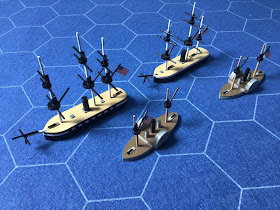This is a long running and continuing journey around a collection of ideas, projects, games, models and a variety of wargaming related themes from my own imagination and from others. As I have been described as having the attention span of a forgetful goldfish you can rest assured the resulting subject matter will be diverse and (usually) entertaining! "He lived in a frenzy of enthusiasm — but nothing lasted for long with him".
Wednesday, 30 April 2025
The Boshin War - The Penultimate Samurai
Tuesday, 29 April 2025
It is the Fort that counts….Part 3
Monday, 28 April 2025
It is the Fort that counts….Part 2
The next fiddly phase has been completed and so the model has now been sealed prior to undercoating and painting. The final fiddly phase will of course, adding the ‘teeth’ - the gun barrels.
Students of military architecture should look away methinks….
Sunday, 27 April 2025
It is the Fort that counts….
When I first started the project that eventually morphed into The Portable Ironclads Wargame I had always planned to build forts, shore and floating batteries. Aside from the two Jenga block blockhouse style buildings I had built sometime ago I had not, up until now, really made any further progress. Anyways, for reasons that will become obvious in due course, I needed to build something rather more ambitious than my earlier models.
This is still a work in progress but I am rather taken with how it is coming along. So without further ado, here is what will eventually be Fort Squaragon.
Wednesday, 23 April 2025
Pictures Telling Stories
Just a brief post for today as a lot is going on. Just three pictures of some of the ACW naval collection, posed for the camera, but why?
Sunday, 20 April 2025
CSS Atlanta: Ready for Action!
Finally got the Spar Torpedo fitted. A simple construction although the original had a much more complex system for lowering the spar boom.
First of all, a happy Easter to all! It has been a busy bank holiday weekend as I am also involved in some DIY so gaming related stuff has taken a bit of a back seat. The available ‘me time’ has been spect preparing for the battle to be fought for Developing the Portable IroncladsWargame: The American Civil war. The scenario has been designed and aside from finishing the CSS Atlanta I also have a terrain piece to get ready - this is currently underway and should be finished in a couple of days or so.
For the spar torpedo rig I used two small pieces of MDF, cut from a Warbases dice frame ‘sprue’. these were placed either side of the bow with a length of cocktail stick for the spar. A large dollop of superglue placed between the two pieces of MDF and on the deck itself ensures that the spar is solidly positioned and hopefully table usage proof!
I have spent a lot of time thinking about how to model the spar torpedo - truthfully I have, as usual, overthought the whole thing. The end result was very much from the school of bodgery but it will suffice!
On with the terrain piece….(once the DIY is finished, naturally!).
Thursday, 17 April 2025
Not Quite The Battle of the River Plate - 1864 style
Wednesday, 16 April 2025
Endgame in Sight!
Two of the final pieces required for the battle report to be found in Developing the Portable Ironclads Wargame: The American Civil War. No prizes for guessing what the Jenga blocks are for. A bonus point if anyone can tell me what needs to be done to the Confederate ironclad - super detailing it or replacing it with a commercially available model as an answer will earn you instant disqualification!
Thanks to a mahoosive amount of work by the Editor-in-Chief, Developing the Portable Ironclads Wargame: The American Civil War, is now really close to being ready for publication! I have some pictures to organise and the battle contained therein needs to be fought and written up but once that has done it is off for proofreading. There will then be some tidying up to take care of and then bingo! “Thar she blows!”
As mentioned previously, this has taken me a lot longer than I originally envisaged to produce and if I am completely honest, it will be with some degree of relief that it gets ‘out there’, so to speak.
For the battle that will feature in the book I have to slightly modify one of the Confederate ships being used and I will also have to complete an item of terrain that will feature. I should also mention that any resemblance to the battle and anything remotely historical will be purely coincidental….
In the words of ‘Ol Blue Eyes….”and now, the end is near….”
Wednesday, 9 April 2025
Turtle Ships and Samurai
Tuesday, 8 April 2025
Squared Away
As part of the preparation for DTPIW I spent some time reworking some of the firing arc pictures as I was not really happy with the original versions. They now look like this:
The eagle-eyed amongst you will have noticed that for the single square option the forward and aft wide arcs (FW and AW) appear to be only covering the area off the bow and stern respectively. This is deliberate but such guns will still be available to use on a broadside if required. There is a rule that covers this and also clarifies the concept of partial grid areas.
I will need to slightly amend the appropriate text to better explain my thinking around this.
In other news, plans are afoot for another action to be fought at the club - this time on the high seas - and every ship present will have a full sailing rig!










































